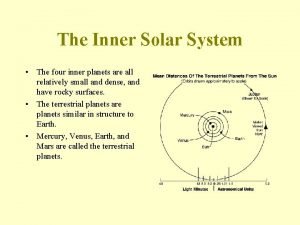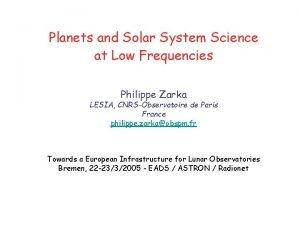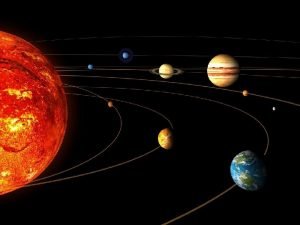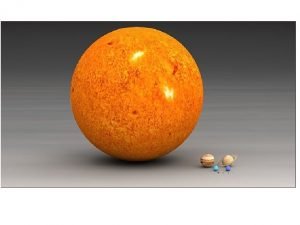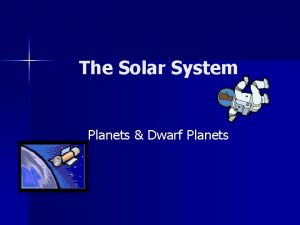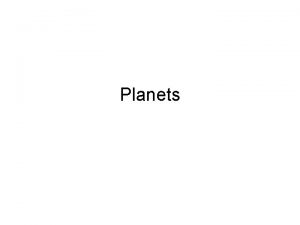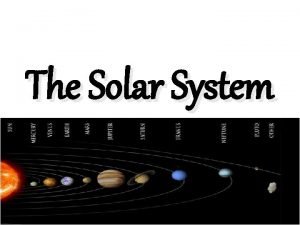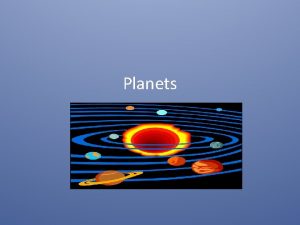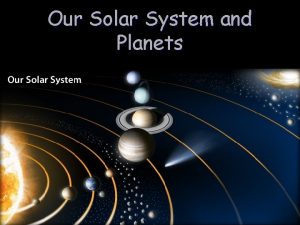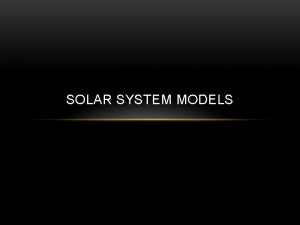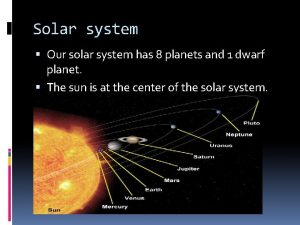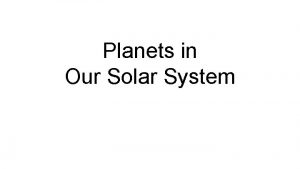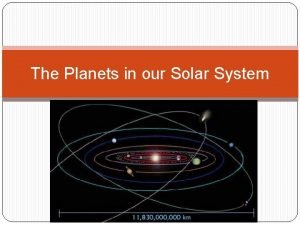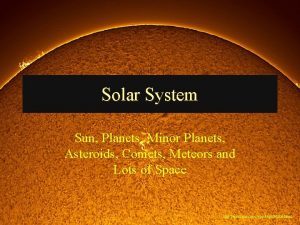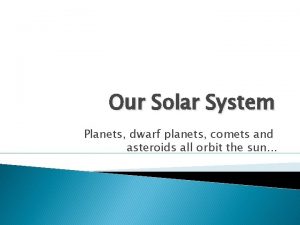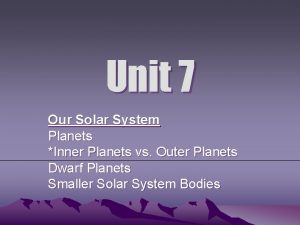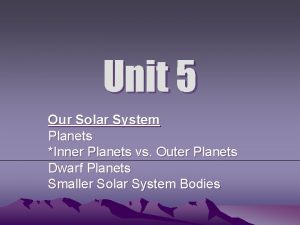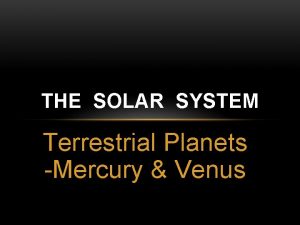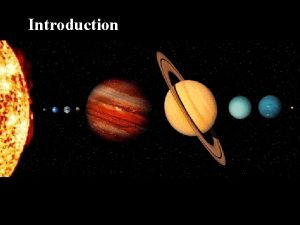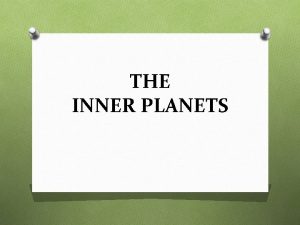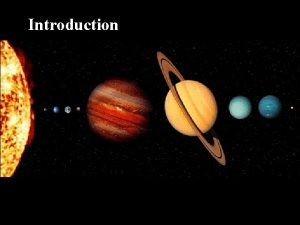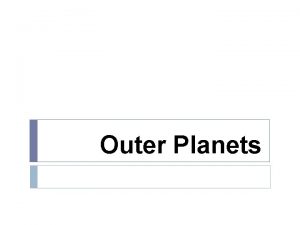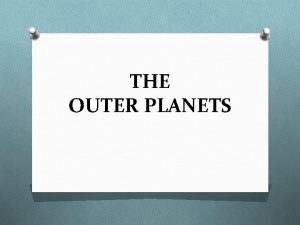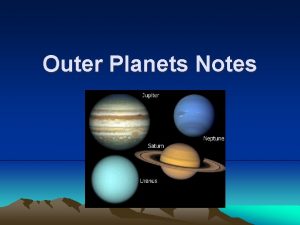Planets of the Solar System CharacteristicsComposition Position Planets









































- Slides: 41

Planets of the Solar System Characteristics/Composition /Position

Planets of the Solar System Planets Gas Giants Terrestrial Mercury Venus Earth Mars Jupiter Saturn Uranus Neptune

The Solar System Song

Terrestrial Planets • These planets are solid and rocky • There are four terrestrial planets Mercury, Venus, Earth and Mars

Mercury Characteristics • • Nearest planet to the Sun Smallest planet No moons 88 Earth days for one revolution around the Sun (88 days = 1 year on Mercury) • It spins slowly 59 Earth days for 1 rotation on its axis

Mercury • • • Iron core / rocky crust Weak gravity – no atmosphere High temperature in the day Low temperature at night Many craters due to no atmosphere

Planet Mercury

Mercury Craters

Mercury Core

Did you know? ? ? • Mercury is the planet which most looks like our Moon – it is full of craters • All gases except traces of vaporized Sodium have been boiled off by the Sun

Venus • • Second Planet from the Sun Almost the size of Earth Internal structure similar to Earth Very hot – average temperature 464 o. C (Earth is 15 o. C) • Thick and Acidic Atmosphere (carbon dioxide & sulphuric acid) • No moon • Spins the opposite direction to Earth

Planet Venus


Venus’s Surface

Did You Know? • You would not be able to see stars from Venus because the atmosphere of thick poisonous gas clouds block out the Sun and stars • The sky looks red and it is impossible to see the surface of Venus from Earth • Venus has rainfall of acid • All space probes that landed on Venus only kept working for 1 hour

Earth • Third planet from the Sun • Rocky surface • Atmosphere present – rich in oxygen and nitrogen little carbon dioxide • Takes 365 ¼ days for one revolution around the Sun • Takes 24 hours to rotate on its axis • Only known planet to have water and support life • Has one moon – called “The Moon”

Earth

Earth’s Atmosphere

Mars • Known as the red planet – due to iron (III) oxide (rust compound) on its surface • 4 th planet from the Sun, last inner planet • Small iron core, rocky crust • Atmosphere – carbon dioxide, no oxygen • Polar icecaps • Two small moons

The Red Planet

Mars’ Moons

Mars’ Surface

Did You Know? • The rocks on Mars contain a lot of iron dust which adds to its color • This dust has been oxidized by the carbon dioxide gas in the atmosphere • This chemical reaction has turned Mars dusty

Jupiter, Saturn, Neptune, Uranus OUTER PLANETS – “GAS GIANTS”

Outer Planets • The outer planets are also known as the Gas Giants, this is because they are huge and composed of gases! • The outer planets are the largest in the solar system

Jupiter • 5 th planet from the sun • Largest and heaviest in the solar system • Atmosphere made of hydrogen with some helium • Spins very fast – so there are violent storms • Home to the Great Red Spot – a storm larger than Earth • Has 63 moons

Jupiter The Great Red Spot (below )

Jupiter’s Moons

Saturn • 6 th planet from the Sun • 2 nd largest in the solar system • Rocky core surrounded by metallic hydrogen • Atmosphere – hydrogen and helicum • Rings composed of ice and space debris • Has about 33 moons. Titan is the largest and is the size of a small planet

Saturn

Saturn’s Moons

Uranus • 7 th planet from the Sun • 3 rd largest and 4 th heaviest • It takes 84 Earth years for one revolution around the Sun • It is extremely cold • Atmosphere – hydrogen with small amount of methane • Methane gives Uranus a cyan (bluegreen) color • It is tilted at an angle of 98 o

Uranus

Uranus Tilt

Uranus Moons

Neptune • 8 th planet from the sun • Atmosphere – mainly hydrogen, some helium and a little methane • These gases gives it a bluish green color • Neptune is extremely cold • Revolution: 165 earth years • Stormiest weather in the solar system – winds 2 000 km/h. Hurricanes on Earth 300 km/h • 13 moons – Triton (largest)

Neptune



Pluto • Pluto is no longer a planet • It is considered a “dwarf planet” • A dwarf planet is one which cannot clear objects out of its path • Pluto is also much smaller than the other planets.

Dwarf Planet – Pluto
 The four inner planets of our solar system are
The four inner planets of our solar system are 4 inner planets
4 inner planets My very excited mother just served us nachos
My very excited mother just served us nachos Solar system planets
Solar system planets Solar system
Solar system Glisside
Glisside Five outer planets
Five outer planets Solar system jeopardy
Solar system jeopardy The inner solar system by leslie
The inner solar system by leslie Inner terrestrial planets
Inner terrestrial planets Why are jovian planets bigger than terrestrial
Why are jovian planets bigger than terrestrial Today planetary position
Today planetary position Wholesalesolar com solar panels
Wholesalesolar com solar panels Inexhaustible source of energy
Inexhaustible source of energy Fundamental position vs anatomical position
Fundamental position vs anatomical position Starting position and derived position
Starting position and derived position Hát kết hợp bộ gõ cơ thể
Hát kết hợp bộ gõ cơ thể Bổ thể
Bổ thể Tỉ lệ cơ thể trẻ em
Tỉ lệ cơ thể trẻ em Chó sói
Chó sói Tư thế worm breton là gì
Tư thế worm breton là gì Chúa yêu trần thế alleluia
Chúa yêu trần thế alleluia Các môn thể thao bắt đầu bằng tiếng nhảy
Các môn thể thao bắt đầu bằng tiếng nhảy Thế nào là hệ số cao nhất
Thế nào là hệ số cao nhất Các châu lục và đại dương trên thế giới
Các châu lục và đại dương trên thế giới Công của trọng lực
Công của trọng lực Trời xanh đây là của chúng ta thể thơ
Trời xanh đây là của chúng ta thể thơ Cách giải mật thư tọa độ
Cách giải mật thư tọa độ Phép trừ bù
Phép trừ bù độ dài liên kết
độ dài liên kết Các châu lục và đại dương trên thế giới
Các châu lục và đại dương trên thế giới Thơ thất ngôn tứ tuyệt đường luật
Thơ thất ngôn tứ tuyệt đường luật Quá trình desamine hóa có thể tạo ra
Quá trình desamine hóa có thể tạo ra Một số thể thơ truyền thống
Một số thể thơ truyền thống Cái miệng bé xinh thế chỉ nói điều hay thôi
Cái miệng bé xinh thế chỉ nói điều hay thôi Vẽ hình chiếu vuông góc của vật thể sau
Vẽ hình chiếu vuông góc của vật thể sau Biện pháp chống mỏi cơ
Biện pháp chống mỏi cơ đặc điểm cơ thể của người tối cổ
đặc điểm cơ thể của người tối cổ Thứ tự các dấu thăng giáng ở hóa biểu
Thứ tự các dấu thăng giáng ở hóa biểu Vẽ hình chiếu đứng bằng cạnh của vật thể
Vẽ hình chiếu đứng bằng cạnh của vật thể Fecboak
Fecboak
